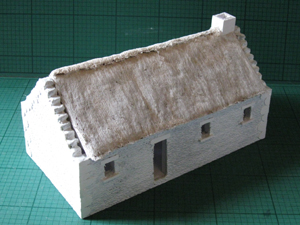I've recently taken an interest in simple 1 or 2 page rules, especially
FUBAR and this has prompted me to extract my stalled 28mm Irish War of Independence project from the lead mountain. It's a pleasure to be painting fewer, larger figures but I'm going for the same 'magic dip' approach I use on 15mm ones rather than three-coat shading and super detailing. The figures are mainly Musketeer and Cannon Fodder. I'm using overscale diecasts for vehicles and my figures are on high bases to compensate. Controversial, but the fudge works for me.
For scenery I've made some buildings from 5mm foamboard and some dry stone walls from cat litter and PVA. I also bought some JRM dirt roads, some Tiger Terrain craggy hills in polyurethane resin (company regretfully no longer operating), and a box of K&M hedges. Here are some of the buildings. I've also made a Victorian-era terrace with back yards. They are all based on photos I found on the Web.
 |
| Thatched cottage. Walls are faced with Natural Stone styrofoam sheeting from Antenocitis Workshop with bits of card stuck on to represent the larger corner stones. Thatch is teddy bear fur from a haberdashery so no teddy bears were harmed in the production of this model. |

